How Girlguiding values brought healing to post-war Europe
This VE Day, we remember the amazing work of the Guide International Service
When victory in Europe was declared 80 years ago, a brave group of Girlguiding members were ready to help.
For VE (Victory in Europe) Day 2025, we're looking back at the hard work and dedication of the women in the Guide International Service (GIS). By carrying out important relief work, they helped people across Europe whose lives had been impacted by the Second World War.
How the Guide International Service (GIS) came to be
While the Second World War was still being fought, there was a small group of young women waging their own personal battle in town and cities across the UK.
They were determined to be selected for the Guide International Service (GIS) and put their Girlguiding values into practice.
Delivering on their promise to always ‘help other people’, an ‘army of goodwill’ was being assembled by Girlguiding to spring into action once peace was finally declared. Their mission was to help ordinary citizens abroad whose lives had been obliterated by the war.
This extraordinary plan came about after Girlguiding’s London HQ received letters from members asking what could be done to help their stricken sister Guides in Europe.
More important even than winning the war is the question of winning the subsequent peace. Whatever happens, Europe will be left weak and exhausted and will need an army of peace – an army mostly composed of women. If we can begin now to collect our “Army of Goodwill”, what could they not do to bring healing and comfort to a stricken world?’ - International Guide Commissioner Rose Kerr in The Guider magazine, February 1941.
Fundraising and setting up the GIS
In April 1942 a committee was set up to organise the new GIS scheme. Many of its members had been involved with relief work after the First World War, and they knew how urgent the need would be.
They all agreed that Girlguiding would be ready to help in whatever form was needed.
The scheme was funded entirely by Girlguiding's young global membership. Fundraising initiatives included mending hot water bottles, gathering rosehips to sell to the Ministry of Food, digging worms to sell for bait, and donating their pocket money, along with numerous appeals.
While Brownies and Guides may have been too young to sign up for the GIS, by the summer of 1945 they had raised over £111,000 to support it.
It fell to older members – older Rangers and Guide leaders aged 21 and over - to enlist. They could start training at 18.
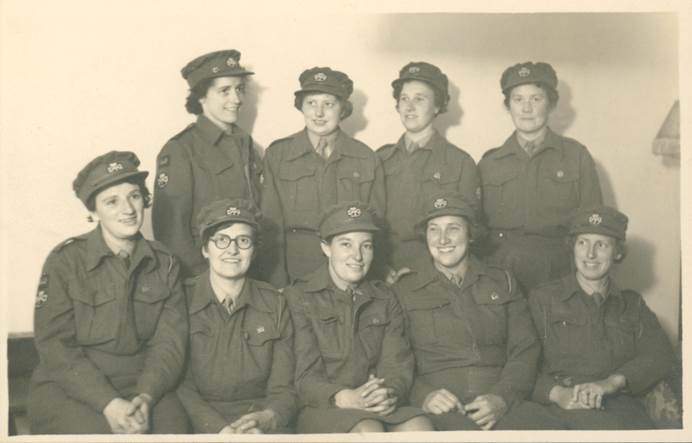
Many of them were experienced campers and resilient team players whose motto was ‘Be Prepared’. They were used to improvising and organising large camps with minimal equipment.
Many had already earned badges giving them essential skills such as ‘first aider’, ‘emergency helper’, ‘farm worker’, ‘motorist’, ‘signaller’ and ‘first class cook’.
With the right training, they'd make the perfect relief workers, ready to turn their hands to whatever work was required, whether it be running refugee camps or setting up feeding stations. Thrill-seekers need not apply.
‘The work will be hard and probably dangerous. There will be no glamour about it. It will certainly involve living and working among people suffering in mind and body, in conditions of dirt, disease, and possibly civil commotion. Only those with sufficient steadfastness of purpose to carry them through the day-to-day hardship, strain and monotony, should volunteer.’ - GIS recruitment leaflet
While they'd be provided with bed, board, transport and a uniform – army-issued khaki green with a Guide trefoil flash – they would not be paid. Instead, they were given just 10 shillings a week pocket money.
Despite this, applications flooded in.
Training and learning new skills
Training was a real test of endurance, resourcefulness, adaptability and leadership, giving volunteers a taste of what may come.
It was carefully planned to assess character, intelligence and physical fitness. As nobody quite knew what lay ahead, they had to be ready for anything.
Instructors were told to ‘work them when they are hungry or thirsty or suffering from lack of sleep! They must learn that when they think they can do no more – they can!’
The GIS women practised packing and dragging a trek cart for miles over rough ground, in preparation for transporting provisions over obliterated roads.
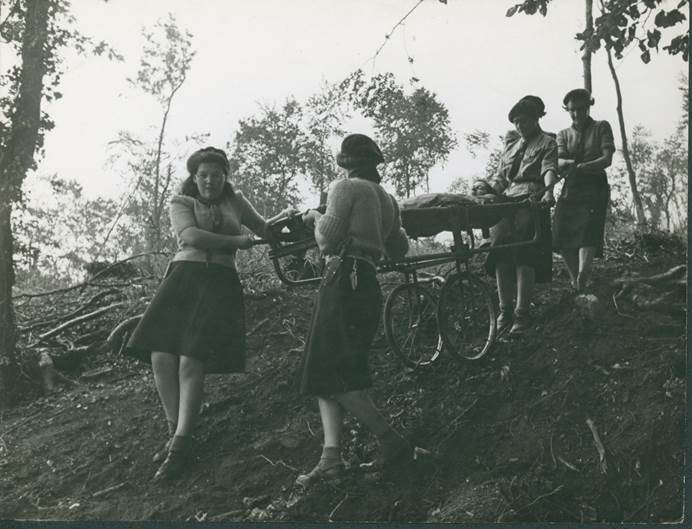
Coping with all kinds of potential emergencies along the way, they learned skills like water decontamination, route finding and making emergency shelters. They laboured on farms and spread muck on fields.
Would-be recruits rehearsed going without food or water for hours, and camping in remote spots in the depths of winter. Compulsory training tasks included lighting outdoor fires with a single match and setting up camp for the night (and packing up again) entirely in the dark.
While some specialised in first aid, cooking or driving, everyone was encouraged to widen their skillset. Suggested activities included treating hysteria, handling a pick axe, handling a cow or goat, volunteering at a hop picking farm, and becoming accustomed to the 24-hour clock.
Every volunteer was expected to study the history, traditions and culture of the countries they were likely to be dispatched to. They also attended lectures on subjects such as hygiene and sanitation.
Successful candidates were picked via a 5-day selection test, which was always held in unfamiliar countryside to them. They didn't know what they would be tested on in advance.
The volunteer, might, in the course of the five days’ test, have to pack and haul a trek-cart, with others, sleep and live hard, fell trees, cope with a carefully arranged accident, work in a nursery or orphanage, find her way by map and compass to an arranged spot, clean out a barn, rest centre or building and take turns in cooking and serving of meals.’ - Guide News Sheet, 1944.
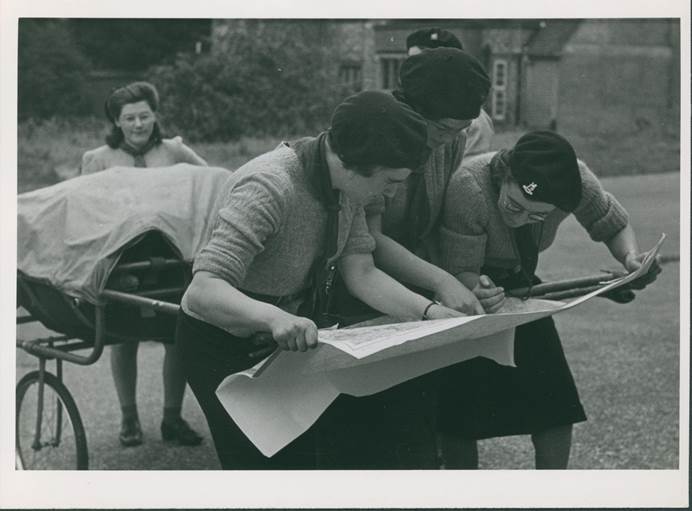
Serving overseas to help those in need
Nearly 200 young women would go on to serve in GIS teams. Most were from Britain. but there were also sister Guides from Commonwealth countries including Australia and New Zealand. They were supported by around 60 Scout leaders.
The first call for relief teams came from Greece early in 1944. Girlguiding were one of the few voluntary organisations who had a team ready to go.
The GIS finally landed in Greece in January 1945, finding a country devastated by famine and occupation. They went on to set up a chain of hostels for refugees, and worked to improve conditions in prisons and hospitals. As the first GIS team in the field, they sent further training advice to their peers who were still at home via the GIS News Sheet.
Practise hitch-hiking. Be able to mount any Army truck or lorry with speed and decency in a narrow skirt. Develop the capacity of a camel as regards liquid. Study pictures of fruit and ices as seen in American magazines in order that the real thing might be less of a shock to the system. Be able to drink tepid salt water without it becoming an emetic. Treat the rear for lorry riding as you do the feet for marching. Be able to agree with varying shades of opinion however foolish you know them to be’. - GIS News Sheet
On VE Day on May 8, 1945, GIS volunteers were among the first relief teams to enter Holland. They crossed into liberated territory just 6 hours after peace had been declared. Arriving at the newly abandoned Amersfoort concentration camp, they later headed to Germany where their first stop was navigating the horror left behind by the Nazis at Bergen-Belsen.
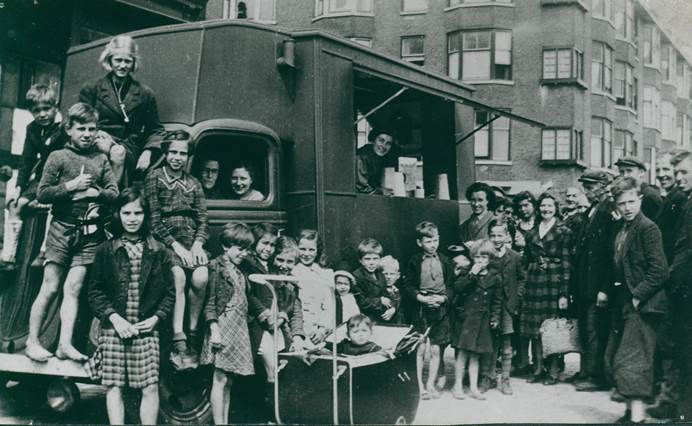
Over 7 years, 13 GIS teams were dispatched to parts of Holland, Germany, Greece, Egypt and peninsular Malaysia (the former British colony of Malaya).
Dedicated to helping those in need, they worked tirelessly in relief camps to help those who needed immediate food, clothing and medical care.
They helped to set up hospitals, feeding schemes, clothing distribution networks, clinics, community centres, clubs, sewing rooms, workshops and nurseries.
A truer manifestation of the Girlguiding spirit would be hard to find. Inspired by the spirit of these intrepid women, Girlguiding remains committed to showing all girls that they can do anything.
Do you have a pioneering story from our history that you’d like to share?
Girlguiding in the news for VE Day 2025
- Guide and Ranger Elodie and Gabby were interviewed live on BBC Radio 5 Live. Listen here from 2:48:00.
- The story of the brave GIS volunteers was featured in the Daily Express.
- Guides Thea, Ruby and Isobel were featured in CBBC Newsround.
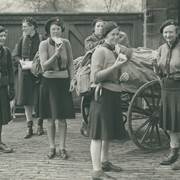
A letter from a GIS volunteer on entering Holland, just 6 hours after peace was declared on VE Day
‘We passed through ruined town after ruined town. Then we passed into liberated territory. Suddenly the road was lined with cheering people, orange scarves, dresses, shirts – everything orange. It was not cheering such as we have known, but the voice of those who had been under enemy occupation and were greeting their friends in freedom. When they saw we were women it seemed to add to their joy. When our trefoil badge was recognised the cry ‘Padvinsters!’ (Dutch name for ‘Guides’) echoed down the line. As the convoy slowed, girls climbed on our vehicles to touch our hands, to touch the golden trefoils on our sleeves – the emblem which they had been forbidden to wear.’
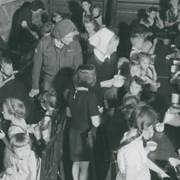
A letter from a GIS volunteer after entering Amersfoort concentration camp
‘I am typing this inside the barbed wire; behind me are the watch-tower and the searchlight which was trained on the enclosure. The conditions inside the huts are appalling. A few of the prisoners are still here – gaunt living skeletons of men are hobbling with spade handles for crutches. Many of their fellow-prisoners lie in unmade pits behind the camp. In one block lie the sick – they have been dying for a long time. For them liberation seems to have come too late.’